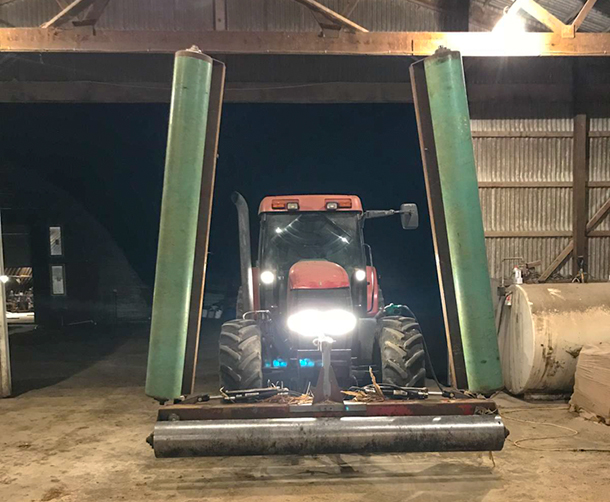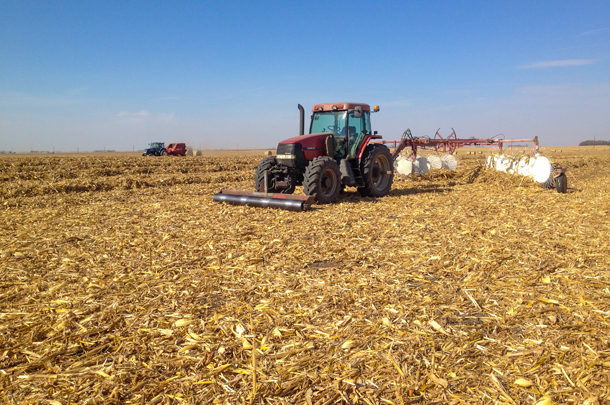While it can be feasible to use cornstalks for grazing and as a no-till ground cover, corn stubble has also become a valuable resource of fiber and roughage to mix with distillers grains in rations and for use as bedding material. Thus, baling cornstalks is on the rise – as are the pockmarked equipment tires and worn-out rake tines that do the work.
Neil Schelling works on the family dairy in Sioux County, Iowa, about nine months out of the year and custom bales cornstalks in the fall. He knows all about the damage cornstalks can do to equipment and tires. For a few years he researched drag-style stalk stompers, but the design didn’t appeal to him.
“If the stalks are too tough, I worried the drag would start to ride up on them instead of mashing them down. The other problem was that any stirring action on the crop right before it goes into the baler might drag dirt into the bale,” he says. Dirt brings a higher ash content if used in a ration and increases the risk of mycotoxins.
Schelling’s first attempt at a solution was to create a 10-foot push-roller that mashed cornstalks immediately in the path of the windrow, mounted on a front three-point hitch on the tractor.
It didn’t take him long to realize that in order to save wear and tear on his rake, he needed to extend the roller to cover everything the rake hits.
“Standing stalks wear rake teeth out quite rapidly,” Schelling says. “Those rakes are made to handle hay, not inch-thick corn stubble.” He also notes if the stalks aren’t smashed down, then the rake can’t do its job well. “It becomes a fight between the standing stubble and the rake tine as to which is going to pull the loose material. There are instances where the cornstalks are so tough they’ll actually pull the material out of the rake teeth.”
Schelling then modified his push-roller design and extended it to 30 feet of coverage – with the existing center 10-foot section, he added two hinged 10-foot sections on each end, using hydraulics to lift the wings for transport.

The rollers are made from 12-inch schedule 20 pipe (1/4-inch wall). At about 33.38 pounds per foot, the rollers weigh roughly 1,000 pounds together. Schelling estimates the frame adds another 500 pounds. “I’m not worried about any compaction issues,” Schelling says. “There’s so little weight on it, if you divide the total weight out along the span, it’s not much. And there’s a fair amount of cornstalk cushion between the roller and dirt. I’m only interested in having enough weight to crush the stalk that’s still standing up after harvest.”
Schelling says, “When I turn around on the ends of the field, I don’t even lift the wings up – I lift the center up and turn. It is somewhat awkward, but it’s considerably more efficient than making a second pass. I’ve seen guys roll with one tractor and then come back and rake with the second tractor, and I don’t have the manpower for that.”
The additional horsepower needed to push the roller “is almost zero,” Schelling says, because once the cornstalks are rolled, it requires less power to pull the rake. “So what I’m putting into the roller power, I’m saving for the most part on the rake end,” he says.
Schelling says it accomplishes a number of things to stomp the stalks before the rake passes over it: It improves the longevity of the tines, allows the rake to do its job better, and in some cases, it smashes dirt clods too so they’re not getting raked into the windrow.
Schelling used the cornstalk roller for the first time in the 2018 season with good success, but if he makes another unit, he’d like to modify it. “The frame design is not what I want,” he says. “When I put this together, I was in a hurry and I knew it was a poor design, but I had to have it for this year,” he says. “The wings have frames on them; those should be eliminated because the 12-inch pipe is structurally strong and it’s stronger than the frame that holds it up. We need to go to frameless wings.”
He would also shorten the wings. “It’s too hard on the frame to have that leverage 10 feet out,” he says. “The other thing is it folds vertically, and that’s not the greatest thing going down the road because it’s a lot of leverage on the three-point hitch. So I’d like to see a system that lays the wings flat so we don’t have that leverage when we’re traveling down the road. At the same time, we’d have a shorter wing to reduce the leverage on the frame in the field as well.”
Schelling chalks this model up to “proof of concept.” There are a lot of things he thinks he can do to improve the durability. But even with its flaws, it’s been an improvement over not having a roller. After putting up 5,000 bales with it (and another 2,000 yet to go as of this writing), he says, “I felt kinda stupid after I saw it work this year. I thought, ‘Why didn’t I do this a long time ago?’ This was a very difficult fall for us. The success of the roller was kind of a bright spot in it all.” ![]()

-
Lynn Jaynes
- Managing Editor
- Progressive Forage
- Email Lynn Jaynes
PHOTO 1: The first version of Neil Schelling’s cornstalk roller consisted of one 10-foot section mounted to the front of the tractor.
PHOTO 2: The second version of the cornstalk roller saw the addition of two 10-foot, hinged wings to cover the expanse of the rake pulled behind. Photos by Neil Schelling.














